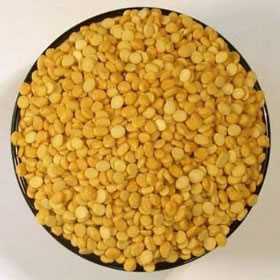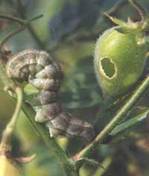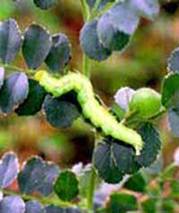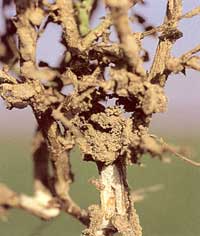Crop Protection : Pests of Bengal Gram
 |
Crop: Bengal gram
Scientific name: Cicer arietinum L.
Common name: Bengal gram
|
Major insect pests of bengal gram
| 1. Gram Pod Borer : Helicoverpa armigera |
Identification of the pest
- Eggs – are spherical in shape and creamy white in colour, laid singly
- Pupa – brown in colour, occurs in soil, leaf, pod and crop debris
- Adult - light pale brownish yellow stout moth.
- Forewing grey to pale brown with V shaped speck.
- Hind wings are pale smoky white with a broad blackish outer margin.
Symptoms of damage
- Skeletinization of leaves – feeding chlorophyll only leaving veins by young larvae Defoliation
- Feeds flower and green pods
- In green pods – make circular holes and feed the grains and make empty.
|
 |
Management
- ETL: 2 early instar larvae/plant
5-8 eggs/plant
- Pheromone traps for Helicoverpa armigera 12/ha
- Bird perches 50/ha
- Hand picking of grown up larvae and blister beetles
- Ha NPV 1.5 x1012 POB/ha with teepol (1 ml/lit.)
Apply any one of the following (Spray fluid 625 ml/ha)
- Dichlorvos 76 WSC 625 ml/ha
- Neem seed kernel extract 5% (31.0 kg/ha) twice followed by
- Triazophos 40 EC 780 ml/ha
- Neem oil 12.5 lit./ha
- Phosalone 35 EC 1.25 lit./ha
(Note : Insecticide / Ha NPV spray should be made when the larvae were
upto third instar) |
| Circular bore hole |
|
Top |
| 2. Semilooper : Autographa nigrisigna |
Symptoms of damage
- Skeletinization of leaves and the plant becomes whitish
- The larvae feed on leaf buds, flowers, tender pods and developing seeds.
- Ragged and irregular pod. (This is in contrast with the neat, and round hole, characteristic of pod borer damage.)
Identification of the pest
- Moths have typically patterned forewings.
- The larva 25 mm long is green semiloopers.
.
|
 |
- ETL 10% affected parts
- Deep summer ploughing in 2-3 years to eliminate quiescent pupa.
- Early sowing, short duration varieties.
- Avoid closer plant spacing.
- Grow tall sorghum as comparison crop to serve as biological bird perches
- Collect and destroy larvae and adults to the extent possible
- Install pheromone traps at a distance of 50 m @ 5 traps/ha for each insect pest.
- Install Bird perches @ 50/ha.
- Setting of light traps (1 light trap/5 acre) to kill moth population.
- Control is achieved by releasing of Trichogramma chlionis at weekly intervals @1.5 lakh/ha/ week for four times.
- Conserve green lacewing, predatory stink bugs, spider, ants
- Application of NPV 250 LE /ha with teepol 0.1% and Jaggery 0.5% thrice at 10 – 15 days interval commencing from flowering stage. (Note: Insecticide / Ha NPV spray should be applied when the larvae are in early stage).
- Bt @ 600 g, neem oil/ pungum oil 80 EC @ 2ml/lit
- Spray NSKE 5% twice followed by triazophos 0.05%.
- Apply any one of insecticides at 25 kg/ha. Chlorpyriphos 1.5 % DP, quinalphos 4D, carbaryl 5D
- Spray insecticides like Carbaryl 10%DP.(OR) Quinalphos 25 EC @ 1000 ml/ha
|
|
Top |
| 3. Cut worm: Agrotis ipsilon |
Symptoms of damage
- The caterpillar remains the soil at a depth of 2-4 inches.
- The caterpillars cut the tender plants at the base, and branches or stems of growing plants.
- The caterpillars drag the cut parts into soil for feeding.
- The buried stem or branches is almost the sure index of the place where the caterpillar is hiding
|
Identification of the pest
- Eggs - are laid on earth clods, chickpea stem bases and on both sides of leaves.
- Larva - is dark brown with red head.
- Pupa -Pupation takes place in earthen cocoon.
- Adult- moth are brownish with numerous wavy lines and spots, measuring 3 to 5 cm across wings
|
Management
- Deep summer ploughing.
- Use well decomposed organic manure.
- Adapt crop rotation.
- Early sowing in the last week of October.
- Intercropping with wheat or Linseed or Mustard reduces infestation.
- In the early stages pick the insects and destroy.
- Do not grow Tomato or Lady Finger in near by field.
- Grow marigold on bunds
- The adult insects can be controlled by light traps
- Spray insecticides like quinalphos 25 EC @ 1000 ml/ha
- In case of severe infestation Spray insecticides like spark 36 EC at the rate of 1000 ml/ha. Profenophos 50 EC @ 1500 ml/ha.
- Dilute the above in 500 - 600 liters water and spray.
|
Top |
| 4. Termites: Odontotermes obesus |
Symptoms of damage
- Termite bores into the roots and stem. Due to the bore the plants soon dries.
- Attack may continue to the standing crop also especially during the period of drought.
|
Identification of the pest
- These are social insects, live in termitaria, in distinct castes, workers, kings and queen.
- Eggs are laid on plants and in the soil.
- 'Worker' are small (4 mm) and have a soft, white body and a brown head.
|
 |
Management
- Frequent intercultural operations and irrigation before sowing.
- Field sanitation, timely disposal of crop stables and undecomposed plant parts.
- Undecomposed FYM or composed should not be used
- Two-three deep ploughing could also help control this pest.
- Destroy the termite bunds in and around the field and kill the queen and complimentary form.
- Seed treatment with chlorpyriphos @ 4ml/kg of seed.
|
| Updated on June, 2014 |
|
|
|

